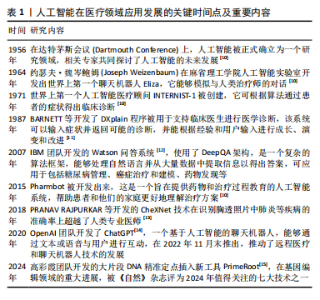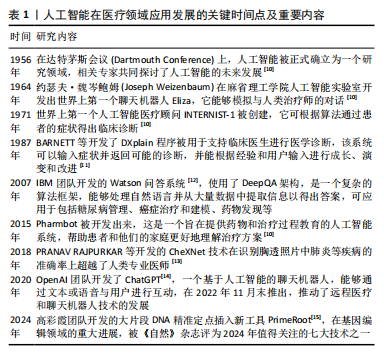Chinese Journal of Tissue Engineering Research ›› 2025, Vol. 29 ›› Issue (29): 6269-6276.doi: 10.12307/2025.759
Previous Articles Next Articles
Application of artificial intelligence in the diagnosis and treatment of lumbar disc herniation: evolution towards standardization, efficiency, and precision of diagnosis and treatment methods
Zhang Ziyu1, 2, Chen Longhao1, 2, 3, Sheng Wei1, 2, Lyu Hanzhe1, 2, Shen Ying1, 2, Wang Binghao1, 2, Lyu Zhizhen1, 2, 3, Lyu Lijiang1, 2, 3
- 1The Third Affiliated Hospital of Zhejiang Chinese Medical University, Hangzhou 310000, Zhejiang Province, China; 2The Third Clinical Medical College of Zhejiang Chinese Medical University, Hangzhou 310000, Zhejiang Province, China; 3The Institute of Tuina (Spinal Disease), Zhejiang Chinese Medical University, Hangzhou 310000, Zhejiang Province, China
-
Received:2024-09-09Accepted:2024-11-13Online:2025-10-18Published:2025-03-08 -
Contact:Lyu Lijiang, Professor, Chief physician, Master’s supervisor/Doctoral supervisor, The Third Affiliated Hospital of Zhejiang Chinese Medical University, Hangzhou 310000, Zhejiang Province, China; The Third Clinical Medical College of Zhejiang Chinese Medical University, Hangzhou 310000, Zhejiang Province, China; The Institute of Tuina (Spinal Disease), Zhejiang Chinese Medical University, Hangzhou 310000, Zhejiang Province, China -
About author:Zhang Ziyu, Master candidate, The Third Affiliated Hospital of Zhejiang Chinese Medical University, Hangzhou 310000, Zhejiang Province, China; The Third Clinical Medical College of Zhejiang Chinese Medical University, Hangzhou 310000, Zhejiang Province, China -
Supported by:The General Program of the National Natural Science Foundation of China, Nos. 82474668, 82274672 (to LLJ); The General Program of the National Natural Science Foundation of China, No. 82305426 (to LZZ); China’s National Administration of Traditional Chinese Medicine (NATCM) Key Disciplines Project for High-Level Traditional Chinese Medicine, No. GJXK2023-85 (to LLJ); Major Research and Development Key Project of Zhejiang Province, No. 2022C03123 (to LLJ)
CLC Number:
Cite this article
Zhang Ziyu, Chen Longhao, Sheng Wei, Lyu Hanzhe, Shen Ying, Wang Binghao, Lyu Zhizhen, Lyu Lijiang. Application of artificial intelligence in the diagnosis and treatment of lumbar disc herniation: evolution towards standardization, efficiency, and precision of diagnosis and treatment methods[J]. Chinese Journal of Tissue Engineering Research, 2025, 29(29): 6269-6276.
share this article
Add to citation manager EndNote|Reference Manager|ProCite|BibTeX|RefWorks
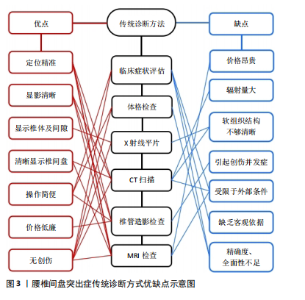
2.2 人工智能技术在腰椎间盘突出症诊断中的作用 2.2.1 腰椎间盘突出症传统诊断方法现状 腰椎间盘突出症的传统诊断方法主要包括临床症状评估、体格检查、X射线平片、CT扫描、椎管造影检查和MRI检查等,这些检查都各具优缺点,见图3。临床症状评估依赖于患者的主观描述,易受个体差异和心理因素的影响,准确性有限;体格检查虽然能够发现部分异常体征,但对病变的定位和程度判断存在局限;X射线平片能够显示椎体和椎间隙的异常,但对软组织结构如椎间盘的显示能力较差;CT扫描在椎间盘和椎管结构的清晰度上具有优势,但较高的辐射剂量限制了其在常规诊断中的频繁使用,在脊髓、韧带及血管等软组织的成像上表现不足,并且易受拍摄条件、设备性能、患者状态等因素的影响,导致图像质量的波动[16]。椎管造影检查作为一种微创诊断手段具有操作简便、成本低廉、创伤小等优势,新型对比剂的易吸收特性和较少的不良反应,加之其精准的定位能力和清晰的显影效果,能够动态观察椎管的纵向情况并获取多角度图像,有助于高节段和多节段椎间盘突出的诊断;此外,椎管造影在避免CT检查可能的漏诊以及排除其他腰痛病因方面,兼具诊断准确性和经济效益的显著优势[17]。 不过作为一种有创性的检查方法,椎管造影检查可能会引发一些并发症如过敏性休克[18],禁用于碘过敏者、穿刺部位感染、椎管内急性出血等人群[19]。MRI检查是目前诊断腰椎间盘突出症的金标准,能够全面显示椎间盘、神经根和硬膜囊等结构,但检查费用较高、易产生相对较多的伪影[20-22],对设备和操作技术要求较高,普及性受限,并且不适用于体内含有金属物品的患者[23-24]。"
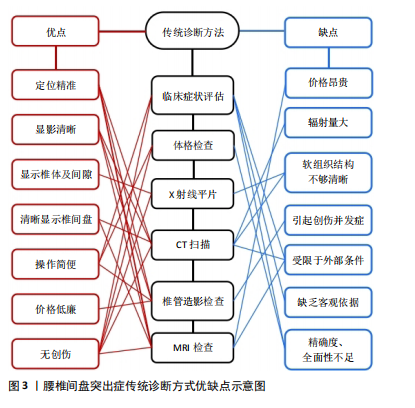
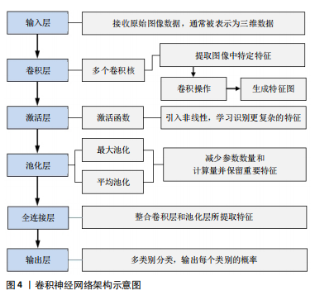
总之,腰椎间盘突出症传统诊断方法各有所长,但各自存在局限性且受限于医生的诊疗水平,因此,探索更为高效、准确的诊断方法对于腰椎间盘突出症的诊治具有重要意义。 2.2.2 基于深度学习对 MRI、CT 图像的分析辅助病情诊断 深度学习技术在医学影像诊断领域的应用,标志着从传统的计算机辅助诊断向智能化诊断的转变。相较于传统的计算机辅助诊断,深度学习通过模拟人脑神经元网络的信息处理机制,显著提升了从MRI和CT图像中自动提取特征的能力[25-26]。MRI和CT扫描提供的高分辨率腰椎结构图像,在腰椎间盘突出症的精确诊断中至关重要。尽管腰椎结构复杂多变、病变类型广泛,但深度学习模型经过适当训练后能够自动识别椎间盘突出的关键特征,如位置、大小和形态等,如ZHANG等[27]开发的模型可以测量MRI影像中椎间盘膨出或突出的大小与方向并自动分型,这为医生提供了更加精确的诊断依据。FAN等[28]的研究将人工智能算法与传统的LBF算法以及PreWork算法作比较,人工智能算法在兼具LBF算法速度快、分割效果好及PreWork抗噪能力强的优点的同时,解决了PreWork弱边缘的处理并不理想和过度曝光的问题,优化了CT图像的灰度分布,实现了邻域间像素间灰度关联,从而实现图像的精确分割。 当前用于辅助诊断的深度学习算法主要包括卷积神经网络[29]、多模态深度学习模型[30]、深度残差网络(ResNet)[31]、生成对抗网络Generative Adversarial Network (GAN)[32]、递归神经网络[33]、迁移学习技术[34]。其中,卷积神经网络是当前最具代表性的一种算法[35],通过将图像输入卷积神经网络传入共享卷积层后将数据转发至特有卷积层及区域生长网络,卷积层使用多个卷积核进行卷积操作即可自动提取MRI、CT图像中的关键特征,随后应用非线性激活函数,构建池化层、全连接层和输出层,在利用标记数据集对模型进行训练后,实现自动诊断[36](图4)。"
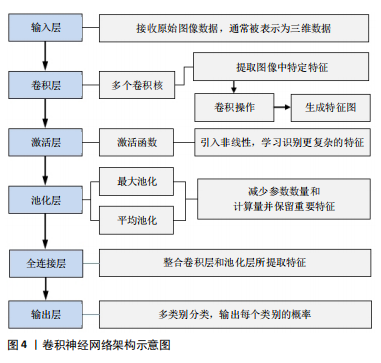
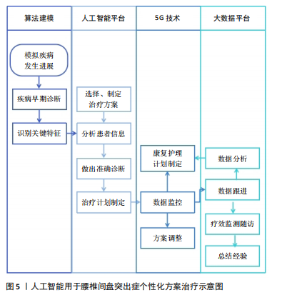
PAN等[37]通过深度卷积神经网络对腰椎间盘MR图像进行诊断的准确率高达84%以上,以卷积神经网络为基础开发出的SCENet深度学习模型以及MSKNet检测模型,在贺泽华[38]研究中的检测准确率达95%以上。ZHENG等[39]开发了一个改进的深度plabv3+分割网络,量化了椎间盘退变的各个参数,利用定量数据评估使诊断更加客观与规范,但卷积神经网络训练通常需要大量的标注数据进行训练,并且对于数据的质量和多样性要求较高。 多模态深度学习模型能够处理和融合多种不同类型数据,其中图像融合在辅助诊断中最为常用,它可用于合并来自各种医学成像系统并包含了解剖和生理数据的特定器官与疾病的图像[40]。首先是图像预处理,通过数据增强技术降低数据维度,同时保留相关信息,如针对图像数据去除模糊、失真的图片,以实现下一步的个体特征提取,图像特征提取常需要结合卷积神经网络或深度残差网络来进行,在特征提取后将提取到的不同模态的特征映射到一个统一的特征空间中,随后再进行模态对齐,其中一个关键方面是图像配准,将来自不同模态的图像对齐到通用坐标系中,使其能够跨图像类型准确匹配相应的解剖结构,这有助于数据分析与模态融合[41]。模态融合可分为早期融合(输入融合)、中间融合和后期融合(输出融合),在早期融合中,原始输入数据被连接,所得向量被视为单模态输入,这意味着深度学习架构不会区分模态特征的来源,使其具有简单性的优点,但可能会被不同模态特征间的相关性和冗余性所影响;在中间融合中,融合学习特征向量形式的边缘表示而不是原始的多模态数据,这种边缘表示可以通过神经网络来学习,其优点在于可以灵活地找到融合边缘表示的正确深度和顺序,但计算复杂度较高;在“晚期融合”中,单独单峰子模型的决策不是组合原始数据或学习特征,而是组合成最终决策,即通过加权平均、逻辑回归等方法将不同模态的预测结果进行组合,得到最终的预测结果,这种方法的优点是灵活性较高,可以根据不同模态的性能和可靠性来调整融合的权重,但可能会忽略不同模态之间的底层特征信息的融合[42]。在模态融合后进行协通推理和训练优化,最后结合具有融合质量评估和调整后的多模态医学数据库分析MRI图像,以达到诊断的目的。 深度残差网络是在传统卷积神经网络基础上发展而来的,它通过创新的结构设计引入了残差学习的概念,解决了传统卷积神经网络在网络深度增加到一定程度后会出现梯度消失或梯度爆炸的问题,避免训练困难、性能下降[43]。深度残差网络的核心组成部分是由多个卷积层以及一个快捷连接组成的残差块,快捷连接允许输入直接跳过一个或多个层,与层的输出相加,这种设计使得网络在反向传播时梯度可以通过快捷连接直接传递,从而解决了梯度消失的问题;残差连接允许网络直接学习恒等映射,使得网络可以更有效地逼近目标函数,显著提高网络性能,这也有助于梯度更好地传播、网络以更快的速度收敛以及让训练过程更稳定,使其相较于传统的深层网络更易训练。深度残差网络在医学图像处理工作中非常有效,能够增强卷积神经网络的特征表示能力,提高医学图像分类分割的性能,并具有良好的泛化能力,在图像分割任务中,简单地用深度残差网络比使用标准模型会得到更好的分割效果[44]。XU等[45]的研究也提到原始残差网络拓扑仍然存在显著缺陷,如很难在非常深的网络上收敛;数据不平衡、标记不当、噪声干扰和可变样本量会导致其在分析医学图像领域面临的问题,模型的性能也可能会因此受到影响,进而导致模型无法很好地泛化和过度拟合或欠拟合。 生成对抗网络是一种特殊类型的神经网络模型,2个网络同时训练,其中一个专注于图像生成,另一个专注于辨别,在图像数据不足或清晰度不够的情况下,可通过图像增强算法最小化由于伪影而导致的重复成像辅助诊断,或生成大量图片数据训练诊断模型,能够以低成本增加图像数量和质量,减少CT辐射暴露和MRI采集时间[46-47]。CHEN等[48]的研究讨论了当前生成对抗网络的不足:在图像重建和跨模态图像合成中生成样本会产生模糊,并且生成的数据与目标域的分布相匹配存在系统偏差。 递归神经网络是一种专门用于处理序列数据的神经网络,能够捕捉图像切片或时间序列一系列医学影像数据的时间信息和上下文关系,分析连续的影像切片,更好地理解病变的发展过程、器官的动态变化等,如在MINIC等[49]研究基于递归神经网络开发的模型在心电图监测中表现优异。对于慢性疾病,递归神经网络医学影像中的病变特征可能与之前的影像状态或历史信息有关,其循环结构使其能够学习长期依赖关系,可通过分析患者的多次影像,运用长短期记忆生成预测训练模型,继而判断疾病的进展情况或治疗效果[50]。同时,递归神经网络对影像切片数量或扫描角度不同等不规则数据有较强适应能力。但递归神经网络容易过拟合,计算效率相对较低,在处理大规模医学图像时可能存在性能瓶颈,因此,在实际应用于影像诊断时常与卷积神经网络结合,卷积神经网络负责提取影像的空间特征,递归神经网络负责提取时间或序列特征。BADAHMAN等[51]的研究使用基于递归神经网络及卷积神经网络开发出的Therapha 软件,通过递归神经网络的记忆能力在图像基础上结合了对患者的问诊内容,降低了仅凭借MRI图像进行诊断的漏诊率。 迁移学习作用主要体现在深度学习模型的训练当中,它能够把一个任务或领域中获得的知识应用到另一个不同但相关的任务或领域中,在面对数据稀缺或计算资源有限的情况时,首先使用预训的卷积神经网络模型作为医学图像分析的起点,随后进行微调和数据增强来训练模型,最后将转移学习与卷积神经网络结合构建出新的混合模型[52]。PRISILLA等[53]的研究表明,以迁移学习构建的YOLOv5x模型对每个节段腰椎间盘突出症的诊断准确率都超过90%,达到了较高的水平。但在实际运用中,迁移学习仍存在局限性:在源领域和目标领域之间的差异过大的情况下会产生“负迁移”的问题,对此在选择源领域和目标领域时应确保它们之间的相似性。 综上所述,几种深度学习算法模型各具优点与局限,当前往往将其中几个模型与算法结合使用以达到扬长避短的效果,对提升腰椎间盘突出症诊断效率与准确率有较大帮助,在临床上提供了更为精确的诊断依据,并辅助了诊断流程的优化,具有极大的实用性与发展潜力。 2.3 人工智能在腰椎间盘突出症治疗中的应用 2.3.1 个性化治疗方案设计 个性化治疗方案设计是人工智能在腰椎间盘突出症诊治中的重要应用之一,通过数据收集、算法分析为每个患者制定个性化的治疗方案,其功能单元及流程如图5所示。在个性化诊断与特征识别方面,计算机辅助建模在系统生物学框架下模拟疾病的发生和进展,有助于早期诊断、识别疾病关键特征[54]。人工智能平台如DeepOral分析患者的临床和遗传信息[55],整合所有可用的患者数据结果(如症状、患者病史和家族史以及部分基因组数据等),辅助医生做出准确诊断并量身定制治疗方案,平台作为负责处理患者数据的健康信息管理专业人员服务于这种个性化医疗模式[56]。同时,人工智能可借助 5G技术对治疗过程进行线上实时监控,时刻关注患者各项身体数据,在发现异常时调整治疗方案,减少意外发生、降低治疗风险并减少医护人员工作负担。另外,对于术后患者,通过人工智能的实时决策支持有助于临床医生制定最优的术后护理方案,减少术后不良反应[57],并通过数据分析制定相应康复计划,依据患者身体状况确定康复训练强度及具体用药等[58]。最后,依托大数据平台的数据跟进,对患者进行长期随访和管理,及时发现并处理复发和并发症,了解并监测治疗效果,为腰椎间盘突出症的临床诊治提供经验,也有助于对疾病的进一步深入研究。"
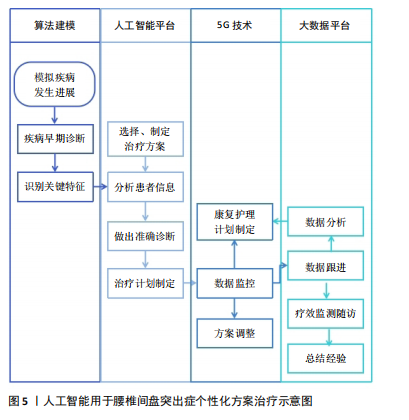
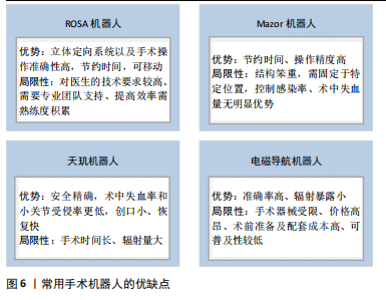
2.3.2 机器人参与或辅助手术治疗的应用 机器人辅助手术系统通过精确的病变组织切除和最小化对正常组织的损伤,展现了其独特的优势,以更小的创伤、更快的恢复速度和较少的并发症,逐渐成为治疗腰椎间盘突出症的优选方法。机器人手术系统把虚拟影像与真正的手术部位进行空间位置的准确叠加与对映,使用立体空间定位技术动态追踪手术器械和解剖结构,使手术医生能够在计算机虚拟影像上看到手术器械与手术部位的实时位置,结合导航技术实现对手术路径的实时规划和调整,使医生可以更加清晰地了解手术区域结构,降低手术安全风险[59]。 目前已有多种机器人手术系统应用于腰椎间盘突出症的治疗,如ROSA机器人[60]、Mazor机器人[61]、中国自主研发的“天玑”机器人(Tinavi)[62]、电磁导航手术机器人(ENSR)等,这些机器人各具特点但也有相应局限性,如图6所示。"
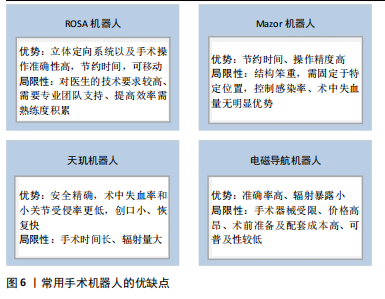

ROSA机器人是脊柱外科精准微创类手术和复杂器械操作机器人技术的代表,采用六度自由机械臂传感技术、无标记点的自动注册技术、患者体位动态追踪技术、复杂器械操作的软件程控技术。RAJGOR等[63]与BRANDMEIR 等[60]的研究证实ROSA机器人的立体定向系统及手术操作具有极高的准确性;MACHETANZ等[64]的研究表明ROSA机器人在时间效率上也具有优势。而ROSA机器人的局限性主要体现在对医生的技术要求较高、需要专业团队支持,并且要想在时间效率方面取得优势需要操作熟练度的积累[65-66]。 Mazor机器人由美敦力公司开发,最新型号为Mazor X,设计理念是为了解决脊柱外科手术中的一些关键问题,如手术创伤、术后修复以及手术的安全性,由工作站、手术臂、导航可视化钻磨系统等结构组成[67]。在术前,Mazor机器人利用相应软件能够提前进行全面术前规划,包括模拟置入虚拟植入物(如螺钉)、手术切口及术后的矫形效果,同时也实现了术前CT扫描与术中荧光透视的共定位,在进行配准之后通过导航系统引导手术臂进行手术操作[68];在实际应用中一定程度上节约了手术时间,螺钉置入精度也非常高,如在AVRUMOVA等[69]的研究中仅有0.6%的偏差率。但Mazor机器人的台式结构使其较为笨重,需要固定在特定位置以保证稳定性及手术臂的可操作范围,这也是其相较于可移动ROSA机器人的劣势,并且在控制感染率、术中失血量等方面Mazor机器人尚未体现出明显优势[70]。 “天玑”机器人由中国自主研发,在脊柱外科手术和创伤骨科手术应用中展现出不俗的性能,由机械臂、手术导航系统和光学跟踪系统组成,分别相当于医生的手、眼、脑,机械臂高度灵活且稳定,负责手术规划和路径定位,而光学跟踪系统负责监测患者参考系和机器人手臂位置,实时跟踪数据,导航系统负责收集术中O形臂扫描重建的3D图像。在辅助微创通道下经椎间孔椎间融合术中,O型臂定位并扫描手术节段,机械臂在指引下置入导丝与椎弓根螺钉,C臂透视确认Cage及钉棒系统位置,多臂协同完成手术[71-72]。LI等[72]的研究表明相比传统手术,“天玑”机器人的螺钉置钉准确率高,术中失血率和小关节受侵率更低,切口长度和住院时间更短。ZHANG等[73]还就“天机”机器人系统置钉的安全性与风险进行研究,研究肯定了其精确性与安全性。但相比传统手术方式,“天玑”系统需要更长的手术时间,而且在术中进行的多次扫描会给患者带来更大的辐射量,这是未来有待改进的方面[74]。 电磁导航机器人系统利用电磁场对手术器械进行定位和跟踪,从而辅助医生进行精确的手术操作,由电磁导航系统、台车、机械臂及末端工具组成硬件部分,同时配套机械臂控制系统、手术导航系统和安全控制系统[75]。 手术开始之前先将电磁导航系统的磁场发生器固定在靠近手术部位的位置,C臂透视摄取正、侧位片并传输到导航主机,并将术前CT三维重建数据集导入导航系统,生成高分辨率的三维模型,用于操作点位和路径规划,机械臂在电磁导航的引导下进行操作,路径与深度、位置均可在显示器上实时显示,并根据实际需要随时进行调节[76]。 电磁导航系统虽然提高了穿刺准确率、减少了辐射暴露[77],但仍然存在一些局限性:铁磁物质会引起电磁场畸变,因此手术中必须避免使用铁磁手术器械[78];作为一种新型辅助导航系统,术前系统设置将会消耗大量时间且需要专业技术人员的协助,并且设备价格高昂,可普及型还有待提高[79]。 除以上几种常用机器人外,机器人结合5G技术使得远程手术成为可能,基于医疗信息互通的医疗信息被数字化并通过有线或无线电信网络传输,医生可以通过网络远程操控手术机器人进行手术。5G技术克服了系统延迟和网络不稳定作为远程手术的主要障碍,如MOUSTRIS等[80]研究显示5G手术机器人在300 km外的延迟仅有18 ms,成功进行了远程手术操作;TIAN等[81]研究显示椎弓根螺钉植入的合格率高达100%,植入位置精准,验证了其可靠性。 2.3.3 大数据技术在疗效评估与预测的应用 人类存储、分析各种数据的能力随着信息技术的快速发展而极大提高,应运而生的大数据技术在各个领域广泛应用[82]。大数据技术可将患者的基本信息、病史、症状、体征等进行收集和整理,形成完整的病例数据库,并支撑大数据平台实现高效的数据处理和分析,常用的有Hadoop 技术及Spark 技术[83]。医疗领域中的检验结果、影像数据等医学数据信息,促使了大量有数据分析处理需求的涌现,涵盖药物研发、患者数据分析等方面,这些数据具备5V特征,属于大数据的范畴[84]。 在诊治过程中,大数据技术的应用为疗效评估提供了新的视角和方法,其能够整合来自众多患者的大规模、多维度数据,借助数据挖掘和机器学习算法深度分析这些数据,从而建立客观且精准的疗效评估和预测模型,在临床上可用于评估穴位、药方及手法的疗效,筛选出常用药方与治疗方案,并对相似患者的治疗提供指导,如活血、补肾、扶正类中药在治疗腰椎间盘突出症临证用药中使用频次最高[85]。大数据技术在治疗选择上也可以选出更合理的方案,OSTERMAN等[86]的研究表明,手术治疗与保守治疗在缓解神经根症状方面相比并没有明显优势,长期保守治疗与早期手术的结果一般不会有显著的差别[87],因此,对于有神经根症状的腰椎间盘突出症患者,选择早期手术的治疗方案并不是非常必要。 在疗效预测方面,大数据技术综合分析大量患者的多方面相关数据信息并代入算法和模型,如基于DL网络和逻辑回归的PROM预测模型[88],能够预测出不同患者在接受特定治疗后的可能疗效。WIRRIES等[89]结合大数据技术开发的深度学习模型,对治疗后6个月的病情预测准确率接近100%,验证了通过疗效预测对治疗方案决策选择的可行性观点[90]。大数据技术指导临床根据患者状况选择最优疗法,如脉冲射频治疗对于腰椎间盘突出症合并糖尿病患者的疼痛缓解效果更佳[91],那么在遇到这样的患者时便可以采用该疗法;对患者术后的后遗症或是恢复情况进行预测,指导其避免相应的不利因素,如内镜腰椎间盘切除术后复发和体质量指数存在相关性,体质量增加复发的可能性更高[92];疼痛、焦虑抑郁都会影响患者术后出现恐动症的概率[93]。 2.4 技术局限性与伦理隐私安全的挑战 目前人工智能在腰椎间盘突出症的诊治中仍存在技术局限性,主要体现在算法的准确性和泛化能力上,基于人工智能结合X射线片图像检测和分析腰椎间盘突出症的发展仍然处于早期阶段,导致对腰椎间盘突出症的诊治仍不够精准。在KIM等[94]的研究中,利用人工智能在X射线片下仅能够诊断髓核是否突出,对严重程度与方向由于缺乏数据而无法精准判断[95];CT图像辅助诊断算法在骶髂关节损伤诊断中误判也较多,容易被组织形变类疾病所干扰[96]。另外,人工智能算法的训练需要大量数据,目前尚无相对规范的关于腰椎间盘突出症的信息数据库或数据平台,信息数据质量参差不齐等问题会导致数据收集与扩充面临一定困难[97]。同时,这些数据的收集和处理受限于伦理和隐私保护,并且人工智能系统在处理患者的医疗信息、影像资料等敏感信息时可能会存在数据泄露、滥用等风险,因此,如何在保障患者隐私的同时充分利用人工智能技术的优势是一个亟待解决的问题,需要多方面共同努力:如加强数据保护和隐私政策的制定、确保患者的信息安全,并完善人工智能伦理教育,提高医务人员与技术人员的伦理意识,以规范人工智能的使用,为患者提供更高质量的医疗服务。 2.5 未来研究方向与临床应用的展望 基于目前人工智能技术在腰椎间盘突出症诊治中的应用,相信它在将来会为腰椎间盘突出症的诊治带来革命性的变化。在智能诊断中结合多种算法的优点集成新型混合学习模型,进一步提升模型训练效率,在根据影像资料的基础上结合其他方面的数据,实现更智能更高效的诊断系统开发;利用大数据打造集成临床专家知识的决策支持框架,提供数据驱动的、个性化的治疗方案建议,以此提升临床决策的质量;在疗效评估与预测方面,更专业化的腰椎间盘突出症患者数据平台构建以及评估预测算法的优化将更有助于提升结果的准确性;在治疗上,辅助手术治疗的机器人现今已在临床逐步投入使用,并取得了一定的成效,但其经济成本以及学习成本需要得到控制,从而达到推广普及的目的;同时,保守治疗的智能化仍有很大的欠缺。针灸、推拿、导引等非药物保守治疗方案作为腰椎间盘突出症治疗中的重要组成部分,在智能化发展中有极大的潜力[98-101],有待进一步研究实行跨学科融合创新,结合人工智能技术与生物医学、材料科学等学科开发新型的诊疗方法和设备,如针灸推拿机器人、辅助椎间盘修复的生物材料等,为腰椎间盘突出症的诊疗提供更多选择,以期在未来更全面化地实现精确诊断与高效治疗。"

| [1] 井夫杰,杨永刚.推拿治疗学-全国中医药行业高等教育“十四五”规划教材(供针灸推拿学、康复治疗学等专业用)新世纪第二版[M].北京:中国中医药出版社,2021. [2] 周莉,吕计宝,蒙珊,等.近5年中医外治疗法治疗腰椎间盘突出症的概述[J].微创医学,2023,18(3):353-356. [3] BENZAKOUR T, IGOUMENOU V, MAVROGENIS AF, et al. Current concepts for lumbar disc herniation. Int Orthop. 2019;43(4):841-851. [4] 詹华奎.诊断学基础[M].上海:上海科学技术出版社,2019. [5] 苏姗姗,石国凤,温丹果,等.中医外治疗法在腰椎间盘突出症患者的应用现状及进展[J].内蒙古中医药,2022,41(11):166-168. [6] 朱斌,田大胜,陈磊,等.单边双通道内镜技术在腰椎疾病中的应用研究进展[J].中华骨科杂志,2020,40(15):1030-1038. [7] 顾永才,王斌义.人工智能概论[M].北京:首都经济贸易大学出版社,2020. [8] 史忠植.人工智能[M].北京:机械工业出版社,2016. [9] 中国发展研究基金.人工智能在医疗健康领域的应用[M].北京:中国发展出版社, 2021. [10] HIRANI R, NORUZI K, KHURAM H, et al. Artificial Intelligence and Healthcare: A Journey through History, Present Innovations, and Future Possibilities. Life (Basel). 2024;14(5):557. [11] ELKIN PL, LIEBOW M, BAUER BA, et al. The introduction of a diagnostic decision support system (DXplain™) into the workflow of a teaching hospital service can decrease the cost of service for diagnostically challenging Diagnostic Related Groups (DRGs). Int J Med Inform. 2010;79(11):772-777. [12] BOHR A, MEMARZADEH K. The rise of artificial intelligence in healthcare applications. Artificial Intelligence in Healthcare. 2020:25-60. doi:10.1016/B978-0-12-818438-7. 00002-2. [13] HABIB N, HASAN MM, REZA MM, et al. Ensemble of CheXNet and VGG-19 Feature Extractor with Random Forest Classifier for Pediatric Pneumonia Detection. SN Comput Sci. 2020;1(6):359. [14] LI J, DADA A, PULADI B, et al. ChatGPT in healthcare: A taxonomy and systematic review. Comput Methods Programs Biomed. 2024;245: 108013. [15] PAN C, QI Y. PrimeRoot for targeted large DNA insertion in plants. Trends Plant Sci. 2023; 28(8):870-872. [16] 欧阳汉强,姜亮,刘晓光,等.人工智能在脊柱影像中的应用现状及发展趋势相关研究进展[J].中国脊柱脊髓杂志,2019,29(12):1129-1132. [17] 许世宏,许世宁.腰椎间盘突出症的四种诊断方法比较[J].山东医药,2005,45(4):78. [18] 孙成祥,许家铭,章锦.临床、椎管造影及CT检查对腰椎间盘突出症诊断的比较分析[J].颈腰痛杂志,1993(3):4. [19] 韩立强,江毅,肖联平,等.椎管造影对腰椎退变性疾病的诊断及治疗方法选择的评价分析[J].实用骨科杂志,2011,17(4):340-344.
[20] 姚岗.CT与MRI在腰椎间盘突出症诊断中的价值[J].临床合理用药杂志,2021,14(7):157-158. [21] 孙伟杰.CT检查在腰椎间盘突出症诊断中的应用价值探讨[J]. 影像研究与医学应用,2024,8(10):123-125. [22] 肖云敏,张丹瑜,冼少青.CT与MRI在腰椎间盘突出症诊断中的临床价值分析[J].生物医学工程学进展,2018,39(4):212-214. [23] 梅莉.MRI与CT诊断腰椎间盘突出症的效果分析[J].影像研究与医学应用,2023, 7(21):183-185. [24] 刘高峰,代志清,王晴晴,等.MRI联合CT检查在腰椎间盘突出症诊断中的应用价值[J].医学影像学杂志,2023,33(7):1316-1318. [25] 张建,谢会群,提克扎提,等.人工智能在骨科影像学诊断中的应用研究进展[J].中国数字医学,2023,18(4):95-103. [26] 崔亚轩,胥义,付强.机器学习在脊柱疾病临床诊断中的应用研究进展 [J].小型微型计算机系统,2020,41(11):2449-2457. [27] ZHANG W, CHEN Z, SU Z, et al. Deep learning-based detection and classification of lumbar disc herniation on magnetic resonance images. JOR Spine. 2023;6(3):e1276. [28] FAN X, QIAO X, WANG Z, et al. Artificial Intelligence-Based CT Imaging on Diagnosis of Patients with Lumbar Disc Herniation by Scalpel Treatment. Comput Intell Neurosci. 2022;2022:3688630. [29] WESSELINK EO, ELLIOTT JM, COPPIETERS MW, et al. Convolutional neural networks for the automatic segmentation of lumbar paraspinal muscles in people with low back pain. Sci Rep. 2022;12(1):13485. [30] HARIBABU M, GURUVIAH V, YOGARAJAH P. Recent Advancements in Multimodal Medical Image Fusion Techniques for Better Diagnosis: An Overview. Curr Med Imaging. 2023;19(7):673-694. [31] LIU D, WANG S, WANG J. The effect of CT high-resolution imaging diagnosis based on deep residual network on the pathology of bladder cancer classification and staging. Comput Methods Programs Biomed. 2022;215:106635. [32] APOSTOLOPOULOS ID, PAPATHANASIOU ND, APOSTOLOPOULOS DJ, et al. Applications of Generative Adversarial Networks (GANs) in Positron Emission Tomography (PET) imaging: A review. Eur J Nucl Med Mol Imaging. 2022;49(11):3717-3739. [33] WANG P, ZHANG Z, XIE Z, et al. Natural Language Processing-Driven Artificial Intelligence Models for the Diagnosis of Lumbar Disc Herniation with L5 and S1 Radiculopathy: A Preliminary Evaluation. World Neurosurg. 2024;189:e300-e309. [34] JECKLIN S, SHEN Y, GOUT A, et al. Domain adaptation strategies for 3D reconstruction of the lumbar spine using real fluoroscopy data. Med Image Anal. 2024;98:103322. [35] 王博.低剂量肺部CT的图像增强及其辅助诊断应用研究[D].成都:电子科技大学, 2020. [36] 蒋正伟.基于深度学习的腰椎间盘突出自动诊断研究[D].青岛:青岛科技大学,2023. [37] PAN Q, ZHANG K, HE L, et al. Automatically Diagnosing Disk Bulge and Disk Herniation With Lumbar Magnetic Resonance Images by Using Deep Convolutional Neural Networks: Method Development Study. JMIR Med Inform. 2021;9(5):e14755. [38] 贺泽华.基于卷积神经网络的腰椎间盘突出症诊断研究[D].桂林:桂林电子科技大学,2023. [39] ZHENG HD, SUN YL, KONG DW, et al. Deep learning-based high-accuracy quantitation for lumbar intervertebral disc degeneration from MRI. Nat Commun. 2022;13(1):841. [40] AZAM MA, KHAN KB, SALAHUDDIN S, et al. A review on multimodal medical image fusion: Compendious analysis of medical modalities, multimodal databases, fusion techniques and quality metrics. Comput Biol Med. 2022;144:105253. [41] LI Y, EL HABIB DAHO M, CONZE PH, et al. A review of deep learning-based information fusion techniques for multimodal medical image classification. Comput Biol Med. 2024;177:108635. [42] STAHLSCHMIDT SR, ULFENBORG B, SYNNERGREN J. Multimodal deep learning for biomedical data fusion: a review. Brief Bioinform. 2022;23(2):bbab569. [43] WU W, QU J, CAI J, et al. Multiresolution residual deep neural network for improving pelvic CBCT image quality. Med Phys. 2022;49(3):1522-1534. [44] CHENG J, TIAN S, YU L, et al. ResGANet: Residual group attention network for medical image classification and segmentation. Med Image Anal. 2022;76:102313. [45] XU W, FU YL, ZHU D. ResNet and its application to medical image processing: Research progress and challenges. Comput Methods Programs Biomed. 2023;240:107660. [46] VEY BL, GICHOYA JW, PRATER A, et al. The Role of Generative Adversarial Networks in Radiation Reduction and Artifact Correction in Medical Imaging. J Am Coll Radiol. 2019;16(9 Pt B):1273-1278. [47] SORIN V, BARASH Y, KONEN E, et al. Creating Artificial Images for Radiology Applications Using Generative Adversarial Networks (GANs)-A Systematic Review. Acad Radiol. 2020; 27(8):1175-1185. [48] CHEN Y, YANG XH, WEI Z, et al. Generative Adversarial Networks in Medical Image augmentation: A review. Comput Biol Med. 2022;144:105382. [49] MINIC A, JOVANOVIC L, BACANIN N, et al. Applying Recurrent Neural Networks for Anomaly Detection in Electrocardiogram Sensor Data. Sensors (Basel). 2023;23(24):9878. [50] DVORNEK NC, YANG D, VENTOLA P, et al. Learning Generalizable Recurrent Neural Networks from Small Task-fMRI Datasets. Med Image Comput Comput Assist Interv. 2018;11072:329-337. [51] BADAHMAN F, ALSOBHI M, ALZAHRANI A, et al. Validating the Accuracy of a Patient-Facing Clinical Decision Support System in Predicting Lumbar Disc Herniation: Diagnostic Accuracy Study. Diagnostics (Basel). 2024;14(17):1870. [52] KIM HE, COSA-LINAN A, SANTHANAM N, et al. Transfer learning for medical image classification: a literature review. BMC Med Imaging. 2022;22(1):69. [53] PRISILLA AA, GUO YL, JAN YK, et al. An approach to the diagnosis of lumbar disc herniation using deep learning models. Front Bioeng Biotechnol. 2023;11:1247112. [54] JIAN J, WANG X, ZHANG J, et al. Molecular landscape for risk prediction and personalized therapeutics of castration-resistant prostate cancer: at a glance. Front Endocrinol (Lausanne). 2024;15:1360430. [55] BEENA KR. Advancements in AI-driven bioinformatics for oral cancer detection and personalized treatment. Oral Oncology Reports, 2024;10. doi:10.1016/j.oor.2024. 100400. [56] PAREKH AE, SHAIKH OA, SIMRAN, et al. Artificial intelligence (AI) in personalized medicine: AI-generated personalized therapy regimens based on genetic and medical history: short communication. Ann Med Surg (Lond). 2023;85(11):5831-5833. [57] KOULAOUZIDIS G, JADCZYK T, IAKOVIDIS DK, et al. Artificial Intelligence in Cardiology-A Narrative Review of Current Status. J Clin Med. 2022;11(13):3910. [58] MOHSIN SN, GAPIZOV A, EKHATOR C, et al. The Role of Artificial Intelligence in Prediction, Risk Stratification, and Personalized Treatment Planning for Congenital Heart Diseases. Cureus. 2023;15(8): e44374. [59] 赵晓飞.机器人辅助与徒手腰骶椎椎弓根螺钉置入的精准度及其影响因素分析[D].郑州:河南大学,2020. [60] BRANDMEIR NJ, SAVALIYA S, ROHATGI P, et al. The comparative accuracy of the ROSA stereotactic robot across a wide range of clinical applications and registration techniques. J Robot Surg. 2018;12(1):157-163. [61] ZHAO W, WANG Y, ZHANG H, et al. Analysis of the Screw Accuracy and Postoperative Efficacy of Screw Placement in Single Position and Bipedal Position in Robot-Assisted Oblique Lumbar Interbody Fusion: Preliminary Results of Mazor X Stealth Usage. Orthop Surg. 2024;16(2):401-411. [62] 郑山,王博,韩振川,等.机器人辅助经椎间孔入路脊柱内窥镜手术治疗单节段腰椎椎间盘突出症[J]. 脊柱外科杂志,2023,21(4):224-229. [63] RAJGOR HD, MAYNE A, MUNASINGHE C, et al. Mako versus ROSA: comparing surgical accuracy in robotic total knee arthroplasty. J Robot Surg. 2024;18(1):33. [64] MACHETANZ K, GRIMM F, SCHUHMANN M, et al. Time Efficiency in Stereotactic Robot-Assisted Surgery: An Appraisal of the Surgical Procedure and Surgeon’s Learning Curve. Stereotact Funct Neurosurg. 2021;99(1):25-33. [65] BATAILLER C, HANNOUCHE D, BENAZZO F, et al. Concepts and techniques of a new robotically assisted technique for total knee arthroplasty: the ROSA knee system. Arch Orthop Trauma Surg. 2021; 141(12):2049-2058. [66] HSU BH, LIU HW, LEE KL, et al. Learning Curve of ROSA ONE Spine System for Transpedicular Screw Placement. Neurospine. 2022;19(2):367-375. [67] LEE NJ, ZUCKERMAN SL, BUCHANAN IA, et al. Is there a difference between navigated and non-navigated robot cohorts in robot-assisted spine surgery? A multicenter, propensity-matched analysis of 2,800 screws and 372 patients. Spine J. 2021;21(9):1504-1512. [68] O’CONNOR TE, O’HEHIR MM, KHAN A, et al. Mazor X Stealth Robotic Technology: A Technical Note. World Neurosurg. 2021;145:435-442. [69] AVRUMOVA F, SIVAGANESAN A, ALLURI RK, et al. Workflow and Efficiency of Robotic-Assisted Navigation in Spine Surgery. HSS J. 2021;17(3):302-307. [70] MAO G, GIGLIOTTI MJ, MYERS D, et al. Single-Surgeon Direct Comparison of O-arm Neuronavigation versus Mazor X Robotic-Guided Posterior Spinal Instrumentation. World Neurosurg. 2020;137:e278-e285. [71] 姜超,张永远,王晓晖,等.机器人辅助微创通道下经椎间孔椎间融合术治疗单节段腰椎间盘突出症的临床疗效[J].西安交通大学学报(医学版),2022,43(5):713-719. [72] LI S, DU J, HUANG Y, et al. Comparison of the efficacies of TINAVI robot-assisted surgery and conventional open surgery for Levine-Edward type IIA (postreduction) hangman fractures. Sci Rep. 2023;13(1):15934. [73] ZHANG RJ, ZHOU LP, ZHANG L, et al. Safety and risk factors of TINAVI robot-assisted percutaneous pedicle screw placement in spinal surgery. J Orthop Surg Res. 2022;17(1): 379. [74] LI S, DU J, HUANG Y, et al. Comparison of surgical efficacy between O-arm combined with CT 3D real-time navigation system and Tinavi robot-assisted treatment of adolescent congenital scoliosis. Am J Transl Res. 2023;15(5):3254-3266. [75] 石运永,林力,吴文波.采用电磁导航技术的手术机器人应用研究[J].中国医疗器械杂志,2023,47(1):26-31. [76] 林涌鹏,李永津,陈博来,等.电磁导航与C臂透视引导经皮椎间孔镜手术治疗腰椎间盘突出症的疗效比较:2年随访[J].实用医学杂志,2021,37(21):2733-2738. [77] 王少纯,陈波涛,李黔春.电磁导航辅助经椎间孔脊柱内窥镜系统治疗腰椎椎间盘突出症[J].脊柱外科杂志,2020,18(6):386-391. [78] SAGI HC, MANOS R, BENZ R, et al. Electromagnetic field-based image-guided spine surgery part one: results of a cadaveric study evaluating lumbar pedicle screw placement. Spine (Phila Pa 1976). 2003;28(17):2013-2018. [79] WU B, WEI T, YAO Z, et al. A real-time 3D electromagnetic navigation system for percutaneous transforaminal endoscopic discectomy in patients with lumbar disc herniation: a retrospective study. BMC Musculoskelet Disord. 2022;23(1):57. [80] MOUSTRIS G, TZAFESTAS C, KONSTANTINIDIS K. A long distance telesurgical demonstration on robotic surgery phantoms over 5G. Int J Comput Assist Radiol Surg. 2023;18(9):1577-1587. [81] TIAN W, FAN M, ZENG C, et al. Telerobotic Spinal Surgery Based on 5G Network: The First 12 Cases. Neurospine. 2020;17(1):114-120. [82] 翁艳.腰椎间盘突出症临床病例数据库的建立及应用[D].成都:四川大学,2021. [83] 车晋强.基于Spark平台的高血压药物推荐及疗效预测研究[D].太原:太原理工大学,2016. [84] 张玢,门佩璇,肖宇锋,等.大数据分析在骨科的应用研究进展[J].中华骨与关节外科杂志,2021,14 (10):866-871. [85] 韩杰,温帅波,徐志为,等.基于数据挖掘探讨国医大师韦贵康治疗腰椎间盘突出症的用药规律[J]. 西部中医药,2024,37(5):66-71. [86] OSTERMAN H, SEITSALO S, KARPPINEN J, et al. Effectiveness of microdiscectomy for lumbar disc herniation: a randomized controlled trial with 2 years of follow-up. Spine (Phila Pa 1976). 2006;31(21):2409-2414. [87] 叶青青.基于数据包络分析(DEA)的气滞血瘀型腰痛病中医综合治疗方案疗效评估[D].成都:成都中医药大学,2020. [88] SHAMIM MS, ENAM SA, QIDWAI U. Fuzzy Logic in neurosurgery: predicting poor outcomes after lumbar disk surgery in 501 consecutive patients. Surg Neurol. 2009; 72(6):565-572; discussion 572. [89] WIRRIES A, GEIGER F, HAMMAD A, et al. Artificial intelligence facilitates decision-making in the treatment of lumbar disc herniations. Eur Spine J. 2021;30(8):2176-2184. [90] WIRRIES A, GEIGER F, HAMMAD A, et al. AI Prediction of Neuropathic Pain after Lumbar Disc Herniation—Machine Learning Reveals Influencing Factors. Biomedicines. 2022;10:1319. [91] 左涌丽,符碧峰,郭圣璇,等.脉冲射频术治疗中老年腰椎间盘突出症患者中长期临床疗效的列线图预测模型构建[J/OL].颈腰痛杂志,1-14[2024-11-15].http://kns.cnki.net/kcms/detail/34.1117.R.20240529.1553.004.html. [92] 梁啸,李东儒,陈筱,等.内镜腰椎间盘切除术后复发的因素及预测模型[J].中国矫形外科杂志,2024,32(9):775-780. [93] 李晓红,陈娟娟.腰椎间盘突出症病人术后发生恐动症的影响因素[J].循证护理, 2024,10(14):2610-2615. [94] KIM JH, LEE SE, JUNG HS, et al. Development and Validation of Deep Learning-Based Algorithms for Predicting Lumbar Herniated Nucleus Pulposus Using Lumbar X-rays. J Pers Med. 2022;12(5):767. [95] 姚红艳,邓兴,陈晓飞,等.腰椎X线摄影人工智能测量技术研究进展[J].中国医学物理学杂志,2021,38(12):1579-1584. [96] 黄鸣宇,吴丽梅,邝晓东,等.CT图像增强辅助诊断系统在椎间盘突出诊断中的应用研究[J].中国医学装备,2020,17(12):44-48. [97] 翟禹樵,李开南.骨科人工智能诊断的研究进展[J].中国临床研究,2021,34(4):542-545. [98] MEJIA MR, ARROYAVE JS, SATURNO M, et al. Use of ChatGPT for Determining Clinical and Surgical Treatment of Lumbar Disc Herniation With Radiculopathy: A North American Spine Society Guideline Comparison. Neurospine. 2024;21(1):149-158. [99] KAYASTHA A, LAKSHMANAN K, VALENTINE MJ, et al. Lumbar disc herniation with radiculopathy: a comparison of NASS guidelines and ChatGPT. N Am Spine Soc J. 2024; 19:100333. [100] DUAN X, XIONG H, LIU R, et al. Enhanced deep leaning model for detection and grading of lumbar disc herniation from MRI. Med Biol Eng Comput. 2024. doi:10.1007/s11517-024-03161-5. [101] Wang P, Zhang Z, Xie Z, et al. Natural Language Processing-Driven Artificial Intelligence Models for the Diagnosis of Lumbar Disc Herniation with L5 and S1 Radiculopathy: A Preliminary Evaluation. World Neurosurg. 2024;189:e300-e309. |
| [1] | Li Jiagen, Chen Yueping, Huang Keqi, Chen Shangtong, Huang Chuanhong. The construction and validation of a prediction model based on multiple machine learning algorithms and the immunomodulatory analysis of rheumatoid arthritis from the perspective of mitophagy [J]. Chinese Journal of Tissue Engineering Research, 2025, 29(在线): 1-15. |
| [2] | Zhang Chunlin, Hou Zhaohua, Yan Xu, Jiang Yan, Fu Su, Ning Yongming, Li Dongzhe, Dong Chao, Liu Xiaokang, Wang Yongkui, Cao Zhengming, Yang Tengyue. Decompression mechanism of symmetrically adduction of lumbar decompression induced resorption of herniated nucleus pulpous [J]. Chinese Journal of Tissue Engineering Research, 2025, 29(9): 1810-1819. |
| [3] | Lu Qi, Sun Maji, Wang Xuezhi, Song Ting, Ma Yiming, Yuan Feng, Chen Hongliang. Two visual arthroplasty techniques for L5-S1 disc herniation: a half-year follow-up evaluation of clinical outcomes [J]. Chinese Journal of Tissue Engineering Research, 2025, 29(9): 1841-1847. |
| [4] | Feng Zhimeng, Sun Ning, Sun Zhaozhong, Li Yuefei, Liu Changzhen, Li Sa. Three-dimensional image reconstruction can safely assist one-hole split endoscope in treatment of #br# L5/S1 far lateral lumbar disc herniation [J]. Chinese Journal of Tissue Engineering Research, 2025, 29(9): 1876-1882. |
| [5] | Wang Mi, Ma Shujie, Liu Yang, Qi Rui. Identification and validation of characterized gene NFE2L2 for ferroptosis in ischemic stroke [J]. Chinese Journal of Tissue Engineering Research, 2025, 29(7): 1466-1474. |
| [6] | Liu Yani, Yang Jinghuan, Lu Huihui, Yi Yufang, Li Zhixiang, Ou Yangfu, Wu Jingli, Wei Bing . Screening of biomarkers for fibromyalgia syndrome and analysis of immune infiltration [J]. Chinese Journal of Tissue Engineering Research, 2025, 29(5): 1091-1100. |
| [7] | Zhi Fang, Zhu Manhua, Xiong Wei, Lin Xingzhen. Analgesic effect of acupuncture in a rat model of lumbar disc herniation [J]. Chinese Journal of Tissue Engineering Research, 2025, 29(5): 936-941. |
| [8] | Yang Bin, Tao Guangyi, Yang Shun, Xu Junjie, Huang Junqing . Visualization analysis of research hotspots of artificial intelligence in field of spinal cord nerve injury and repair [J]. Chinese Journal of Tissue Engineering Research, 2025, 29(4): 761-770. |
| [9] | Yang Dingyan, Yu Zhenqiu, Yang Zhongyu. Machine learning-based analysis of neutrophil-associated potential biomarkers for acute myocardial infarction [J]. Chinese Journal of Tissue Engineering Research, 2025, 29(36): 7909-7920. |
| [10] | Tian Yushi, Fu Qiang, Li Ji . Bioinformatics identification and validation of mitochondrial genes related to acute myocardial infarction [J]. Chinese Journal of Tissue Engineering Research, 2025, 29(31): 6697-6707. |
| [11] | Song Haoran, Zhang Yuqiang, Gu Na, Zhi Xiaodong, Wang Wei. Visualization analysis of artificial intelligence in bone trauma research based on Citespace [J]. Chinese Journal of Tissue Engineering Research, 2025, 29(3): 493-502. |
| [12] | Du Juan, Zhang Yi, Hao Quanshui. Effects of exercise on activation of microglia and astrocytes and neuronal apoptosis in depressed rats [J]. Chinese Journal of Tissue Engineering Research, 2025, 29(29): 6243-6248. |
| [13] | Wang Jiaru, Zhang Ying, Yang Yong, Qi Wen, Xiao Huaye, Ma Qiuping, Yang Lianzhao, Luo Ziwei, He Yaqing, Zhang Jiangyin, Wei Jiawen, Meng Yuan, Tan Silian. Systematic review of machine learning models for predicting functional recovery and prognosis in stroke [J]. Chinese Journal of Tissue Engineering Research, 2025, 29(29): 6317-6325. |
| [14] |
Wang Qianliang, Zhang Qianzhongyi, Peng Yujian, Yan Jun.
Effects of unilateral biportal endoscopic transforaminal lumbar interbody fusion on paraspinal muscles
[J]. Chinese Journal of Tissue Engineering Research, 2025, 29(27): 5862-5868.
|
| [15] | Bai Liang, Fu Su, Yan Xu, Zhang Chunlin, Li Ying . Measurement of intervertebral disc height and analysis of strength after induced resorption of herniated nucleus pulpous [J]. Chinese Journal of Tissue Engineering Research, 2025, 29(27): 5785-5794. |
| Viewed | ||||||
|
Full text |
|
|||||
|
Abstract |
|
|||||
